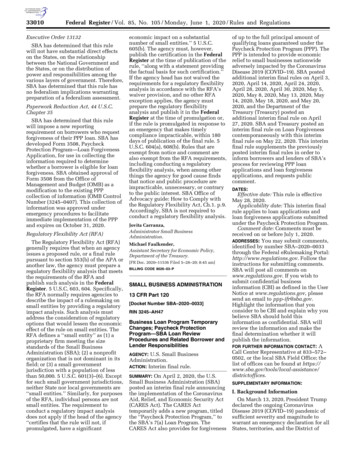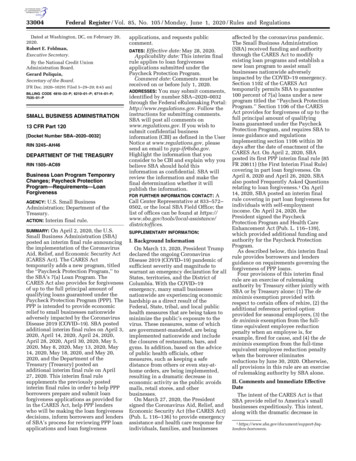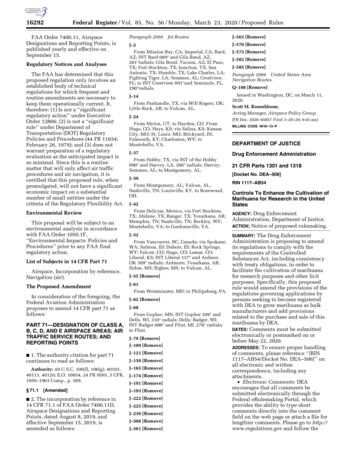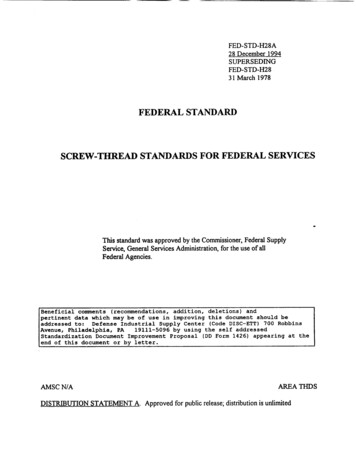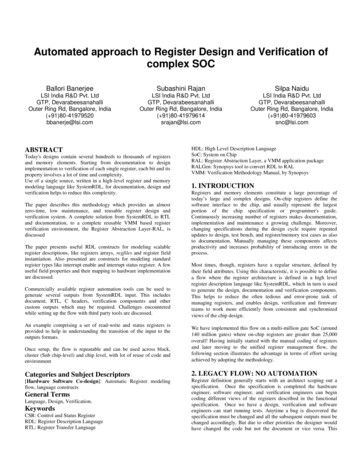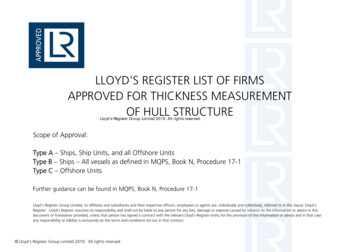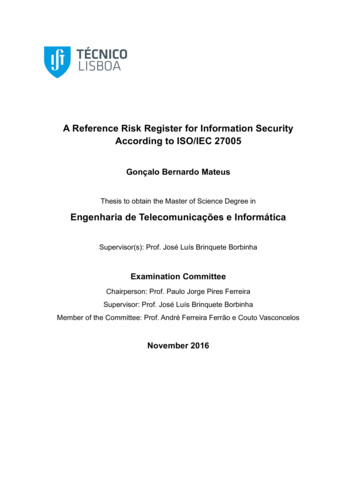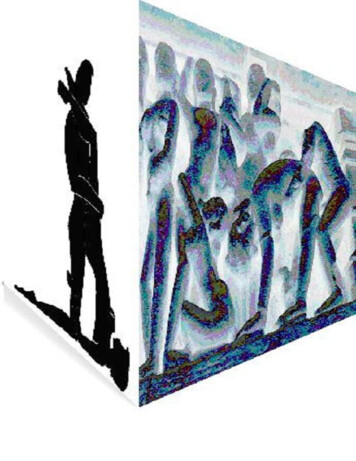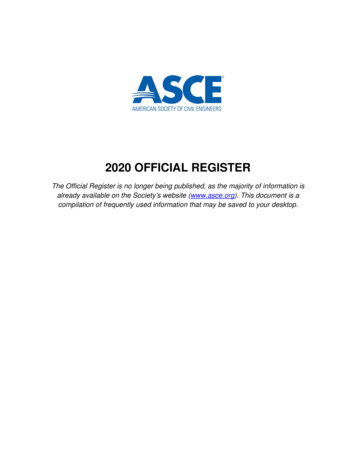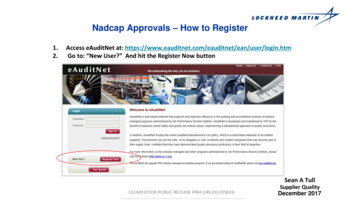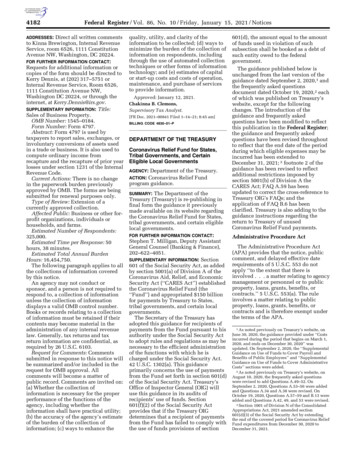
Transcription
4182Federal Register / Vol. 86, No. 10 / Friday, January 15, 2021 / NoticesDirect all written commentsto Kinna Brewington, Internal RevenueService, room 6526, 1111 ConstitutionAvenue NW, Washington, DC 20224.FOR FURTHER INFORMATION CONTACT:Requests for additional information orcopies of the form should be directed toKerry Dennis, at (202) 317–5751 orInternal Revenue Service, Room 6526,1111 Constitution Avenue NW,Washington DC 20224, or through theinternet, at Kerry.Dennis@irs.gov.SUPPLEMENTARY INFORMATION: Title:Sales of Business Property.OMB Number: 1545–0184.Form Number: Form 4797.Abstract: Form 4797 is used bytaxpayers to report sales, exchanges, orinvoluntary conversions of assets usedin a trade or business. It is also used tocompute ordinary income fromrecapture and the recapture of prior yearlosses under section 1231 of the InternalRevenue Code.Current Actions: There is no changein the paperwork burden previouslyapproved by OMB. The forms are beingsubmitted for renewal purposes only.Type of Review: Extension of acurrently approved collection.Affected Public: Business or other forprofit organizations, individuals orhouseholds, and farms.Estimated Number of Respondents:325,000.Estimated Time per Response: 50hours, 38 minutes.Estimated Total Annual BurdenHours: 16,454,750.The following paragraph applies to allthe collections of information coveredby this notice.An agency may not conduct orsponsor, and a person is not required torespond to, a collection of informationunless the collection of informationdisplays a valid OMB control number.Books or records relating to a collectionof information must be retained if theircontents may become material in theadministration of any internal revenuelaw. Generally, tax returns and taxreturn information are confidential, asrequired by 26 U.S.C. 6103.Request for Comments: Commentssubmitted in response to this notice willbe summarized and/or included in therequest for OMB approval. Allcomments will become a matter ofpublic record. Comments are invited on:(a) Whether the collection ofinformation is necessary for the properperformance of the functions of theagency, including whether theinformation shall have practical utility;(b) the accuracy of the agency’s estimateof the burden of the collection ofinformation; (c) ways to enhance theADDRESSES:VerDate Sep 11 201405:39 Jan 15, 2021Jkt 253001quality, utility, and clarity of theinformation to be collected; (d) ways tominimize the burden of the collection ofinformation on respondents, includingthrough the use of automated collectiontechniques or other forms of informationtechnology; and (e) estimates of capitalor start-up costs and costs of operation,maintenance, and purchase of servicesto provide information.Approved: January 12, 2021.Chakinna B. Clemons,Supervisory Tax Analyst.[FR Doc. 2021–00841 Filed 1–14–21; 8:45 am]BILLING CODE 4830–01–PDEPARTMENT OF THE TREASURYCoronavirus Relief Fund for States,Tribal Governments, and CertainEligible Local GovernmentsDepartment of the Treasury.Coronavirus Relief Fundprogram guidance.AGENCY:ACTION:SUMMARY: The Department of theTreasury (Treasury) is re-publishing infinal form the guidance it previouslymade available on its website regardingthe Coronavirus Relief Fund for States,tribal governments, and certain eligiblelocal governments.FOR FURTHER INFORMATION CONTACT:Stephen T. Milligan, Deputy AssistantGeneral Counsel (Banking & Finance),202–622–4051.SUPPLEMENTARY INFORMATION: Section601 of the Social Security Act, as addedby section 5001(a) of Division A of theCoronavirus Aid, Relief, and EconomicSecurity Act (‘‘CARES Act’’) establishedthe Coronavirus Relief Fund (the‘‘Fund’’) and appropriated 150 billionfor payments by Treasury to States,tribal governments, and certain localgovernments.The Secretary of the Treasury hasadopted this guidance for recipients ofpayments from the Fund pursuant to hisauthority under the Social Security Actto adopt rules and regulations as may benecessary to the efficient administrationof the functions with which he ischarged under the Social Security Act.42 U.S.C. 1302(a). This guidanceprimarily concerns the use of paymentsfrom the Fund set forth in section 601(d)of the Social Security Act. Treasury’sOffice of Inspector General (OIG) willuse this guidance in its audits ofrecipients’ use of funds. Section601(f)(2) of the Social Security Actprovides that if the Treasury OIGdetermines that a recipient of paymentsfrom the Fund has failed to comply withthe use of funds provisions of sectionPO 00000Frm 00196Fmt 4703Sfmt 4703601(d), the amount equal to the amountof funds used in violation of suchsubsection shall be booked as a debt ofsuch entity owed to the federalgovernment.The guidance published below isunchanged from the last version of theguidance dated September 2, 2020,1 andthe frequently asked questionsdocument dated October 19, 2020,2 eachof which was published on Treasury’swebsite, except for the followingchanges. The introduction of theguidance and frequently askedquestions have been modified to reflectthis publication in the Federal Register;the guidance and frequently askedquestions have been revised throughoutto reflect that the end date of the periodduring which eligible expenses may beincurred has been extended toDecember 31, 2021; 3 footnote 2 of theguidance has been revised to reflectadditional restrictions imposed bysection 5001(b) of Division A theCARES Act; FAQ A.59 has beenupdated to correct the cross-reference toTreasury OIG’s FAQs; and theapplication of FAQ B.6 has beenclarified. Treasury is also adding to theguidance instructions regarding thereturn to Treasury of unusedCoronavirus Relief Fund payments.Administrative Procedure ActThe Administrative Procedure Act(APA) provides that the notice, publiccomment, and delayed effective daterequirements of 5 U.S.C. 553 do notapply ‘‘to the extent that there isinvolved . . . a matter relating to agencymanagement or personnel or to publicproperty, loans, grants, benefits, orcontracts.’’ 5 U.S.C. 553(a). The ruleinvolves a matter relating to publicproperty, loans, grants, benefits, orcontracts and is therefore exempt underthe terms of the APA.1 As noted previously on Treasury’s website, onJune 30, 2020, the guidance provided under ‘‘Costsincurred during the period that begins on March 1,2020, and ends on December 30, 2020’’ wasupdated. On September 2, 2020, the ‘‘SupplementalGuidance on Use of Funds to Cover Payroll andBenefits of Public Employees’’ and ‘‘SupplementalGuidance on Use of Funds to Cover AdministrativeCosts’’ sections were added.2 As noted previously on Treasury’s website, onAugust 10, 2020, the frequently asked questionswere revised to add Questions A.49–52. OnSeptember 2, 2020, Questions A.53–56 were addedand Questions A.34 and A.38 were revised. OnOctober 19, 2020, Questions A.57–59 and B.13 wereadded and Questions A.42, 49, and 53 were revised.3 Section 1001 of Division N of the ConsolidatedAppropriations Act, 2021 amended section601(d)(3) of the Social Security Act by extendingthe end of the covered period for Coronavirus ReliefFund expenditures from December 30, 2020 toDecember 31, 2021.E:\FR\FM\15JAN1.SGM15JAN1
Federal Register / Vol. 86, No. 10 / Friday, January 15, 2021 / NoticesRegulatory Flexibility AnalysisThe Regulatory Flexibility Act doesnot apply to a rulemaking when ageneral notice of proposed rulemakingis not required.Paperwork Reduction ActThe final rule contains norequirements subject to the PaperworkReduction Act.Authority and Issuance42 U.S.C. 1302(a).Coronavirus Relief Fund Guidance forState, Territorial, Local, and TribalGovernmentsThe purpose of this document is toprovide guidance to recipients of thefunding available under section 601(a)of the Social Security Act, as added bysection 5001 of the Coronavirus Aid,Relief, and Economic Security Act(‘‘CARES Act’’). The CARES Actestablished the Coronavirus Relief Fund(the ‘‘Fund’’) and appropriated 150billion to the Fund. Under the CARESAct, the Fund is to be used to makepayments for specified uses to Statesand certain local governments; theDistrict of Columbia and U.S. Territories(consisting of the Commonwealth ofPuerto Rico, the United States VirginIslands, Guam, American Samoa, andthe Commonwealth of the NorthernMariana Islands); and Tribalgovernments.The CARES Act provides thatpayments from the Fund may only beused to cover costs that—1. are necessary expendituresincurred due to the public healthemergency with respect to theCoronavirus Disease 2019 (COVID–19);2. were not accounted for in thebudget most recently approved as ofMarch 27, 2020 (the date of enactmentof the CARES Act) for the State orgovernment; and3. were incurred during the periodthat begins on March 1, 2020, and endson December 31, 2021.1The guidance that follows sets forththe Department of the Treasury’sinterpretation of these limitations on thepermissible use of Fund payments.Necessary Expenditures Incurred Due tothe Public Health EmergencyThe requirement that expenditures beincurred ‘‘due to’’ the public healthemergency means that expendituresmust be used for actions taken torespond to the public health emergency.1 See Section 601(d) of the Social Security Act, asadded by section 5001 of the CARES Act and asamended by section 1001 of Division N of theConsolidated Appropriations Act, 2021.VerDate Sep 11 201405:39 Jan 15, 2021Jkt 253001These may include expendituresincurred to allow the State, territorial,local, or Tribal government to responddirectly to the emergency, such as byaddressing medical or public healthneeds, as well as expenditures incurredto respond to second-order effects of theemergency, such as by providingeconomic support to those sufferingfrom employment or businessinterruptions due to COVID–19-relatedbusiness closures. Funds may not beused to fill shortfalls in governmentrevenue to cover expenditures thatwould not otherwise qualify under thestatute. Although a broad range of usesis allowed, revenue replacement is nota permissible use of Fund payments.The statute also specifies thatexpenditures using Fund paymentsmust be ‘‘necessary.’’ The Department ofthe Treasury understands this termbroadly to mean that the expenditure isreasonably necessary for its intendeduse in the reasonable judgment of thegovernment officials responsible forspending Fund payments.Costs Not Accounted for in the BudgetMost Recently Approved as of March 27,2020The CARES Act also requires thatpayments be used only to cover coststhat were not accounted for in thebudget most recently approved as ofMarch 27, 2020. A cost meets thisrequirement if either (a) the cost cannotlawfully be funded using a line item,allotment, or allocation within thatbudget or (b) the cost is for asubstantially different use from anyexpected use of funds in such a lineitem, allotment, or allocation.The ‘‘most recently approved’’ budgetrefers to the enacted budget for therelevant fiscal period for the particulargovernment, without taking intoaccount subsequent supplementalappropriations enacted or otherbudgetary adjustments made by thatgovernment in response to the COVID–19 public health emergency. A cost isnot considered to have been accountedfor in a budget merely because it couldbe met using a budgetary stabilizationfund, rainy day fund, or similar reserveaccount.Costs Incurred During the Period ThatBegins on March 1, 2020, and Ends onDecember 31, 2021Finally, the CARES Act provides thatpayments from the Fund may only beused to cover costs that were incurredduring the period that begins on March1, 2020, and ends on December 31, 2021(the ‘‘covered period’’). Putting thisrequirement together with the otherprovisions discussed above, sectionPO 00000Frm 00197Fmt 4703Sfmt 47034183601(d) may be summarized as providingthat a State, local, or tribal governmentmay use payments from the Fund onlyto cover previously unbudgeted costs ofnecessary expenditures incurred due tothe COVID–19 public health emergencyduring the covered period.Initial guidance released on April 22,2020, provided that the cost of anexpenditure is incurred when therecipient has expended funds to coverthe cost. Upon further consideration andinformed by an understanding of State,local, and tribal government practices,Treasury is clarifying that for a cost tobe considered to have been incurred,performance or delivery must occurduring the covered period but paymentof funds need not be made during thattime (though it is generally expectedthat this will take place within 90 daysof a cost being incurred). For instance,in the case of a lease of equipment orother property, irrespective of whenpayment occurs, the cost of a leasepayment shall be considered to havebeen incurred for the period of the leasethat is within the covered period but nototherwise. Furthermore, in all cases itmust be necessary that performance ordelivery take place during the coveredperiod. Thus the cost of a good orservice received during the coveredperiod will not be considered eligibleunder section 601(d) if there is no needfor receipt until after the covered periodhas expired.Goods delivered in the covered periodneed not be used during the coveredperiod in all cases. For example, thecost of a good that must be delivered inDecember in order to be available foruse in January could be covered usingpayments from the Fund. Additionally,the cost of goods purchased in bulk anddelivered during the covered periodmay be covered using payments fromthe Fund if a portion of the goods isordered for use in the covered period,the bulk purchase is consistent with therecipient’s usual procurement policiesand practices, and it is impractical totrack and record when the items wereused. A recipient may use paymentsfrom the Fund to purchase a durablegood that is to be used during thecurrent period and in subsequentperiods if the acquisition in the coveredperiod was necessary due to the publichealth emergency.Given that it is not always possible toestimate with precision when a good orservice will be
4182 Federal Register/Vol. 86, No. 10/Friday, January 15, 2021/Notices 1 As noted previously on Treasury’s website, on June 30, 2020, the guidance provided under ‘‘Costs incurred during the period that begins on March 1, 2020, and ends on December 30, 2020’’ was
